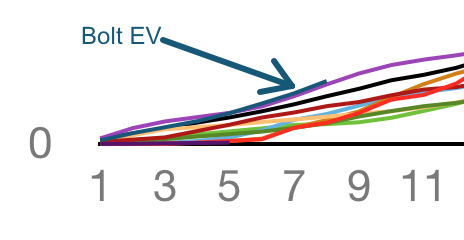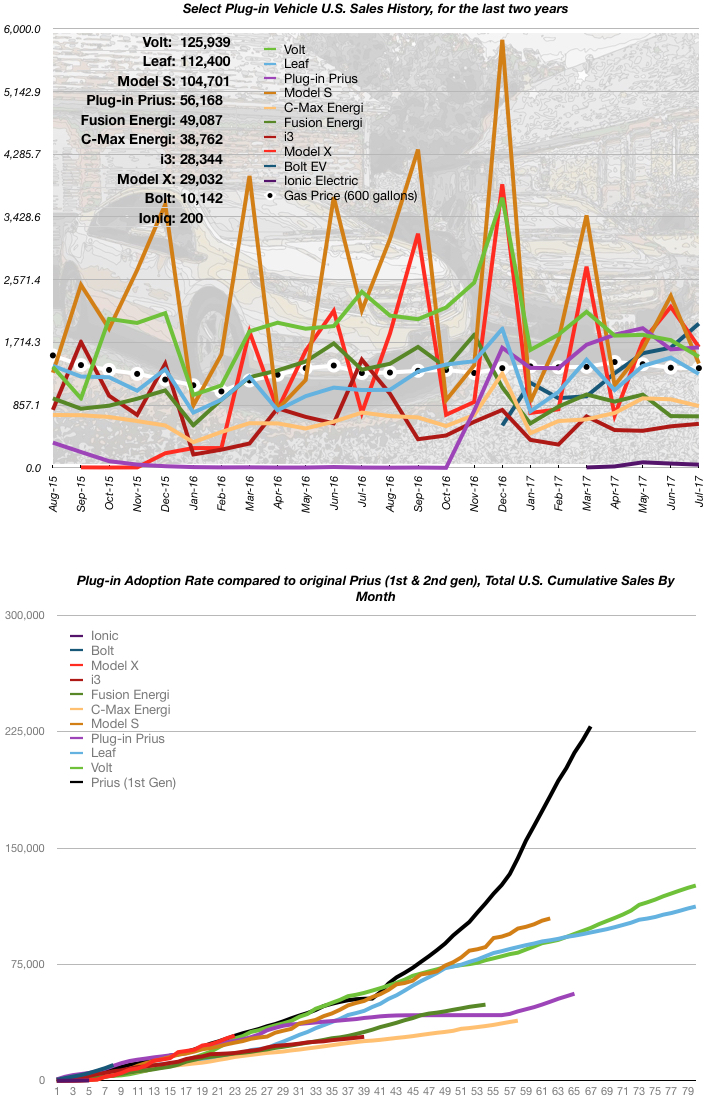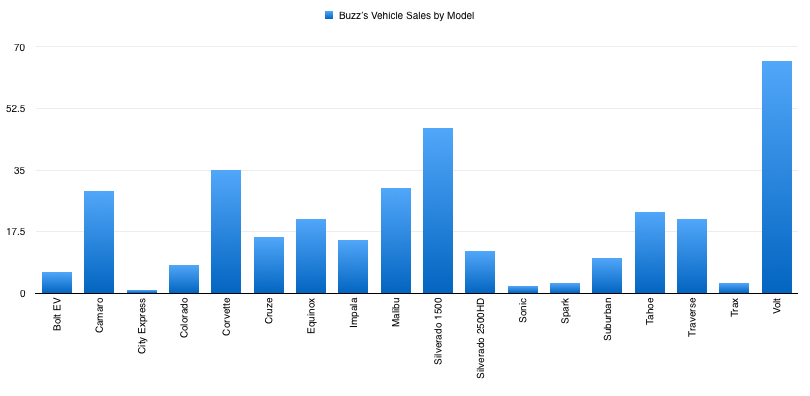 July 2017 plug-in vehicle sales were mostly down with a couple up slightly, and the Chevy Bolt EV jumping up 20%, as it continues it’s rollout across the U.S. The image to the left shows the adoption curves of the plug-in vehicles I track, including the original Prius (non-plug-in). As can be seen, the Bolt EV has outperformed them all, over the first eight months of availability, even though it is still not available in all states yet!
July 2017 plug-in vehicle sales were mostly down with a couple up slightly, and the Chevy Bolt EV jumping up 20%, as it continues it’s rollout across the U.S. The image to the left shows the adoption curves of the plug-in vehicles I track, including the original Prius (non-plug-in). As can be seen, the Bolt EV has outperformed them all, over the first eight months of availability, even though it is still not available in all states yet!
For the last three years, July has been a pretty good month for me. This July was pretty good as well, mainly due to my Bolt EV customers’ orders beginning to arrive. My final Bolt EV sale of the month is an interesting story. The daughter of the dealership’s owner gets a new demo vehicle, about every six months. She could pretty much have any vehicle here, but her last two choices had been Volts (fully loaded Premiers). In July, she decided to purchase a vehicle: The Bolt EV. Stay tuned. I hope to have a video interview with her soon.
I mentioned last month that the 2018 Volt was about to go into production. Production has started and my first two 2018 Volts have been built! More on that in a later post…
 Here are the July 2017 sales figures, compared to the previous month:
Here are the July 2017 sales figures, compared to the previous month:
- Chevy Volt: DOWN 13% (1,518 vs. 1,745)
- Chevy Bolt EV: UP 20% (1,971 vs. 1,642)
- Nissan Leaf: DOWN 15% (1,283 vs. 1,506)
- Plug-in Toyota Prius: UP 2% (1,645 vs. 1,619)
- Tesla Model S: DOWN 39% (1,425 vs. 2,350) **estimated
- Tesla Model X: DOWN 25% (1,650 vs. 2,200) **estimated
- BMW i3: UP 6% (601 vs. 567)
- Ford Fusion Energi: DOWN 1% (703 vs. 707)
- Ford C-Max Energy: DOWN 10% (844 vs. 936)
- Hyundai Ioniq Electric: DOWN 26% (43 vs. 58)
In July, the average price of gasoline was about the same as the previous month, $2.27. It bottomed out on the 4th of July, at $2.22, but rose 11 cents per gallon over the rest of the month, ending at $2.33.
 As I mentioned earlier, July 2017 marked my first Bolt EV sales. In the graph above, the largest bar for June and July is red, representing a tie for best July ever and the best June I have ever had. But notice its size, compared to all the other red bars for 2017. Things are getting better???
As I mentioned earlier, July 2017 marked my first Bolt EV sales. In the graph above, the largest bar for June and July is red, representing a tie for best July ever and the best June I have ever had. But notice its size, compared to all the other red bars for 2017. Things are getting better???
 My July sales were comprised of six Bolt EVs, three Malibus (still no, not hybrids), and a Volt . As in June, I did not sell a single Silverado pickup, so the Volt continues to be my most popular vehicle, but the Bolt EV has already surpassed my career sales of four other vehicles: the City Express van, Sonic, Spark and Trax.
My July sales were comprised of six Bolt EVs, three Malibus (still no, not hybrids), and a Volt . As in June, I did not sell a single Silverado pickup, so the Volt continues to be my most popular vehicle, but the Bolt EV has already surpassed my career sales of four other vehicles: the City Express van, Sonic, Spark and Trax.
Plug-in sales, compared to the same month a year ago, were mixed.
- Chevy Volt: DOWN 37% (1,518 vs. 2,406) **2017 model year ended, awaiting 2018?
- Chevy Bolt EV: (was not available in July 2016)
- Nissan Leaf: UP 21% (1,283 vs. 1,063)
- Plug-in Toyota Prius: UP 41,025% (1,645 vs. 4) **previous generation Prius plug-in, dying out last July
- Tesla Model S: DOWN 34% (1,425 vs. 2,150)
- Tesla Model X: UP 120% (1,650 vs. 750)
- BMW i3: DOWN 59% (601 vs. 1,479)
- Ford Fusion Energi: DOWN 48% (703 vs. 1,341)
- Ford C-Max Energi: UP 12% (844 vs. 755)
- Hyundai Ioniq Electric: (was not available in July 2016)

Are the Malibu hybrids more difficult to sell? Or are they just being sold by other salesmen?
I would have thought the malibu Hybrid would justify the higher price tag. The efficiency improvements there are large compared to the standard Malibu. Not to mention GMs eAssist hybrids or the older eco models.
This year is odd. Malibu (non-hybrids) have had substantial discounts (up to $7K). Due to this, the price difference with the hybrid has been too high. Buyers, reacting to our ads, have been coming in to get steeply discounted Malibus, which were used in our Service loaner fleet. I don’t think the dealership has ever put a Malibu Hybrid into loaner service, so they didn’t have the steep discounts the other Malibus had. I have only sold one Malibu Hybrid myself and that was to a Volt customer of mine, who was buying for his college-bound son. He LOVED it.
I searched for a Toyota Prius Prime, their new plug-in, and, within 150 miles, found only two, one in Plano and one in Temple. I guess Toyota isn’t serious about selling them.
Not to sound snarky, but why? I have not been able to understand why anyone would be interested in the Prius Prime. It has MUCH less range than competing plug-in hybrids and does not qualify for the entire $7,500 Income Tax Credit. Due to this, the buyer’s actual cost is much closer to several far superior vehicles.
Just because I have been wondering why I never see them on the street, and I suspected it was because the dealers weren’t selling them.
I would never buy one for the reasons you mentioned. 25 miles of AER is pathetic when the Volt will do 50.
I don’t understand it either. But someone with a Prime just moved into the other building of our apartment complex and seems to be charging every day so that’s good.
I wouldn’t buy the car, but I’m guessing she is a long time prius driver. And she probably couldn’t stand the idea of looking at the ugly 2017 hybrid Prius every day.
At least the Prius Prime doesn’t look like it was just in a fender bender.